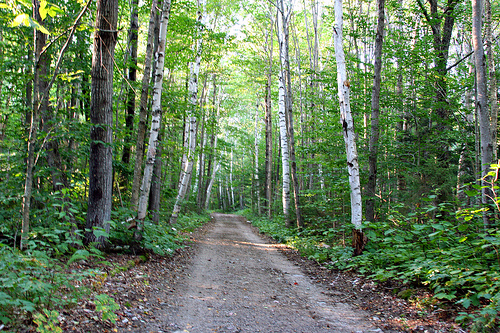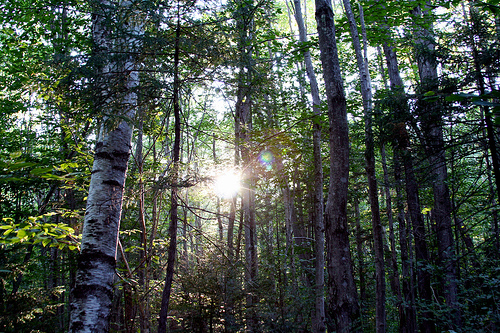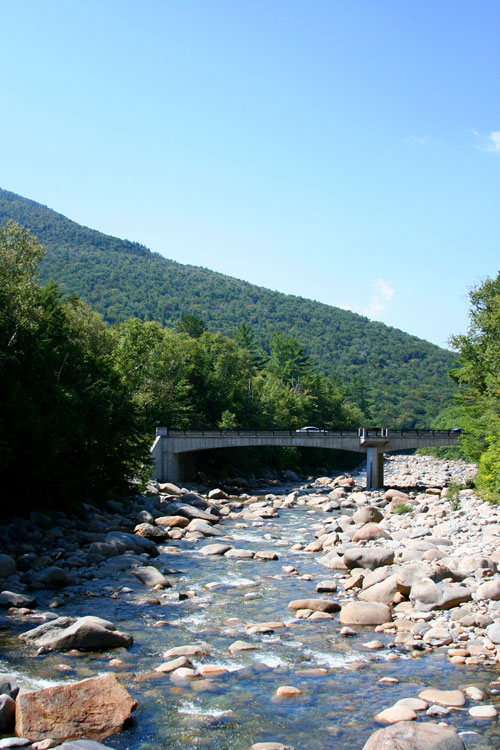 Magnificent white birch trees of the Pemigewassett Wilderness
Magnificent white birch trees of the Pemigewassett Wilderness
Vagabondish is reader-supported. When you buy through links on our site, we may earn a small affiliate commission. Read our disclosure.
K was booked with work for Labor Day weekend, so I decided to take a “walk in the woods” as Bill Bryson would say. Last Sunday, I headed up to Lincoln, New Hampshire – not far from the foot of popular (and quite touristy) Loon Mountain – for some solo backcountry camping.
Five miles from the base of Loon, a large parking lot marks the head of two trails that run parallel to the East Branch of the Pemigewassett River: the Pemi East Side trail runs along the river’s east bank, the Wilderness Trail to its west. The entire twelve mile loop provides some of the easiest, yet scenic, hiking in the White Mountains. The only caveat is that its immense popularity means you’ll have plenty of company. Throngs of tourists and locals alike mob this well-worn loop, particularly the Wilderness Trail because of its link to the public swimming lagoons of Franconia Falls.
night one: making camp
In my opinion, it’s best to start the loop via the less crowded and slightly more interesting Pemi East Side Trail. Beginning my hike around six p.m., I didn’t pass a single other person on my way to the campsite. For me, camping is about solitude, so being completely alone is just fine in my book. From the trailhead, I hiked a leisurely three miles to Franconia Brook campsite – a series of twenty-odd tent sites with and without platforms. I discovered later that a nominal $8 nightly fee – payable at the parking lot ranger station – is levied per site.
 The lush, wet emerald forest is like an otherworldly Star Wars movie set
The lush, wet emerald forest is like an otherworldly Star Wars movie set
The late start meant I wound up making camp and scrambling for (rather damp) fire wood about an hour before dusk. I boiled a cup of dried soup and sat peacefully on a rock stool, warming myself by the fire. Evidently, I was sitting too close to the tree behind me because an angry little rodent peeked around the bark and began shouting at me in Chipmunk-ese. It went on for ten minutes and all I could do was laugh. Eventually he must’ve gotten bored and moved on to do whatever it is that chipmunks do.
I hadn’t been camping since 2005 and I’d rather forgotten the blissful quiet the wilderness affords. I listened to the occasional cracking of tree branches while unseen hikers gathered tinder for their own fires, as I did for mine.
After the fire snuffed out and I clicked my headlamp off, visibility dropped to less than zero. What’s darker than jet black? Whatever that color is, that’s how dark it was for as far as I could (not) see.
Shortly after ten, I fell asleep to the babbling of the Pemigewassett River as it slowly crawled over miles of perfectly sculpted river rocks.
An hour later, I awoke to something scratching and brushing against my tent. I froze. Then it went quiet. Then the noise came again. Picture yourself zipped inside the darkest space you can imagine with only a few millimeters of ripstop nylon between you and an ominous, animal-like clawing sound. Is it a chipmunk? A moose? A black bear? The damp forest acts like an ultra sensitive sound system, amplifying every cracking branch and rustling leaf to the point that you feel like you’re constantly being stalked by something. Whatever it was moved on eventually and I drifted off to a full night of intermittent sleep.
breaking camp and moving on
I awoke in the early morning to my chipmunk friend gathering berries and maniacally running around for no good reason that I could discern. It turned out that he was the one making all the racket the night before. I felt good knowing that I was not, in fact, being sniffed out by a hungry grizzly; yet dismayed that I wouldn’t have a great story to tell later.
The weather was incredible both days of my hike with air temperatures hovering in the seventies and nary a cloud in the sky. It was perfect for photo opps.
I packed up my gear, sacked my tent and headed for the rock footpath that crosses the Pemigewassett River, only a few hundred yards from where I slept. If you can’t wait to cross the river at one of the suspension bridges marking either end of the Pemi East Side Trail, then the foot path is the only other way across. The AMC White Mountain Guide lists this crossing as “difficult” in high water. With a forty pound pack on, I’m going to guess that that’s pretty accurate. The water didn’t appear particularly high that day but it was still a pain in the arse to precariously balance myself on a hundred foot string of wet river rocks.
a waterfall all to myself
Across the river, a rough path leads a hundred or so feet up to the Franconia Falls trail. A short hike to the end of this trail (conveniently marked with a sign that says … wait for it … “End of Trail”) rewards hikers with a look down beautiful Franconia Falls. The “falls” are more like a series of deep lagoons that collectively serve as a natural water park complete with rock water slides. Children and families come from miles around (judging by the license plates on the cars at the trailhead and the flocks of kids carrying beach towels) to swim this natural little wonder.
Even in late summer, the water’s plenty cold enough to induce what George Costanza would call “shrinkage“. Suffice it to say, I skipped a dip. I did sit for an hour in the crook of the smooth, sloping rock “couches” near the top of the Falls, quietly contemplating poetry and other deep intellectual endeavors. It really is quite remarkable to have an entire waterfall to yourself for an hour.
 A view from the suspension bridge at the Wilderness Trail trailhead
A view from the suspension bridge at the Wilderness Trail trailhead
A short while later, I returned to the head of the Franconia Falls trail and began the long, boring hike down the flat, poker-straight Wilderness Trail. The photo above, taken from a suspension bridge, marks the western end of the trial, where I began, and a lovely mountain view to boot.
All and all, it was a great hike and one that I’d highly recommend for families or novice campers who are looking to get their feet wet with some light backcountry camping.


